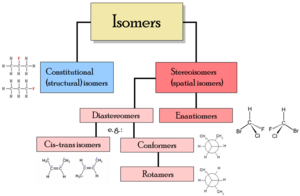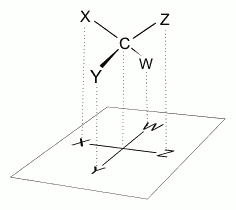Stereochemistry facts for kids

Stereochemistry is a part of chemistry that looks at how atoms are arranged in molecules in three-dimensional space. Think of it like building blocks: even with the same blocks, you can build different shapes. The word stereo means "three-dimensional," so it's often called 3D chemistry.
Chemists use stereochemistry to understand how molecules are related to each other. They can study how these different 3D arrangements affect a molecule's properties. This includes how a molecule acts physically or biologically. When the arrangement affects how a molecule reacts, it's called dynamic stereochemistry.
Some molecules can exist in different forms, even if they are made of the exact same atoms. These different forms are called isomers. There are two main types of isomers. Constitutional isomers have the same atoms, but the atoms are connected in different ways. Stereoisomers have the same atoms connected in the same way, but their atoms are arranged differently in space.
An important part of stereochemistry is studying chiral molecules. These molecules are like your hands: they look almost the same, but one is a mirror image of the other and cannot be perfectly placed on top of it.
In most chemical bonds, atoms can move around without breaking their connections. However, when a molecule has a double bond or a ring shape, its movement is limited. This can lead to different isomers, which are molecules with the same chemical formula but different shapes.
Stereochemistry is important in many areas of chemistry. This includes organic, inorganic, biological, physical, and supramolecular chemistry.
Contents
How Stereochemistry Was Discovered
Louis Pasteur was the first scientist to study stereochemistry. In 1849, he noticed something interesting about salts from tartaric acid. These salts came from wine-making equipment. He saw that they could turn a special kind of light called plane polarized light. But similar salts from other places did not do this.
This ability to turn light was the only difference between the two types of salt. It was due to something called optical isomerism. Later, in 1874, two scientists, Jacobus Henricus van 't Hoff and Joseph Le Bel, figured out why. They discovered that the difference was caused by how atoms were connected to carbon atoms in a special four-sided (tetrahedral) shape.
Why Stereochemistry Matters
Stereochemistry played a big role in solving the thalidomide disaster in the 1960s. Thalidomide was a drug made in Germany in 1957. Doctors gave it to pregnant women to help with morning sickness. Sadly, the drug later caused serious deformations in babies.
Scientists found that one form (isomer) of the drug was safe. But the other form caused serious harm to the developing embryos. The human body can even change the safe form into the harmful one. This event, called the thalidomide disaster, led governments to test new drugs much more carefully. Today, new drugs are first tested on selected people in clinical trials before they are available to everyone. Thalidomide is now used to treat leprosy in some cases.
Describing Molecule Shapes

When an atom can have other atoms connected to it in different 3D ways, it's called a stereocenter. For example, if a carbon atom has four different groups attached to it, it becomes a stereocenter.
The Cahn Ingold Prelog priority rules are a way to describe a molecule's stereochemistry. These rules help chemists rank the atoms around a stereocenter in a standard order. This makes it very clear how these atoms are arranged in the molecule. A Fischer projection is a simple drawing method to show the 3D arrangement around a stereocenter on a flat piece of paper.
Related Topics
See also
 In Spanish: Estereoquímica para niños
In Spanish: Estereoquímica para niños


